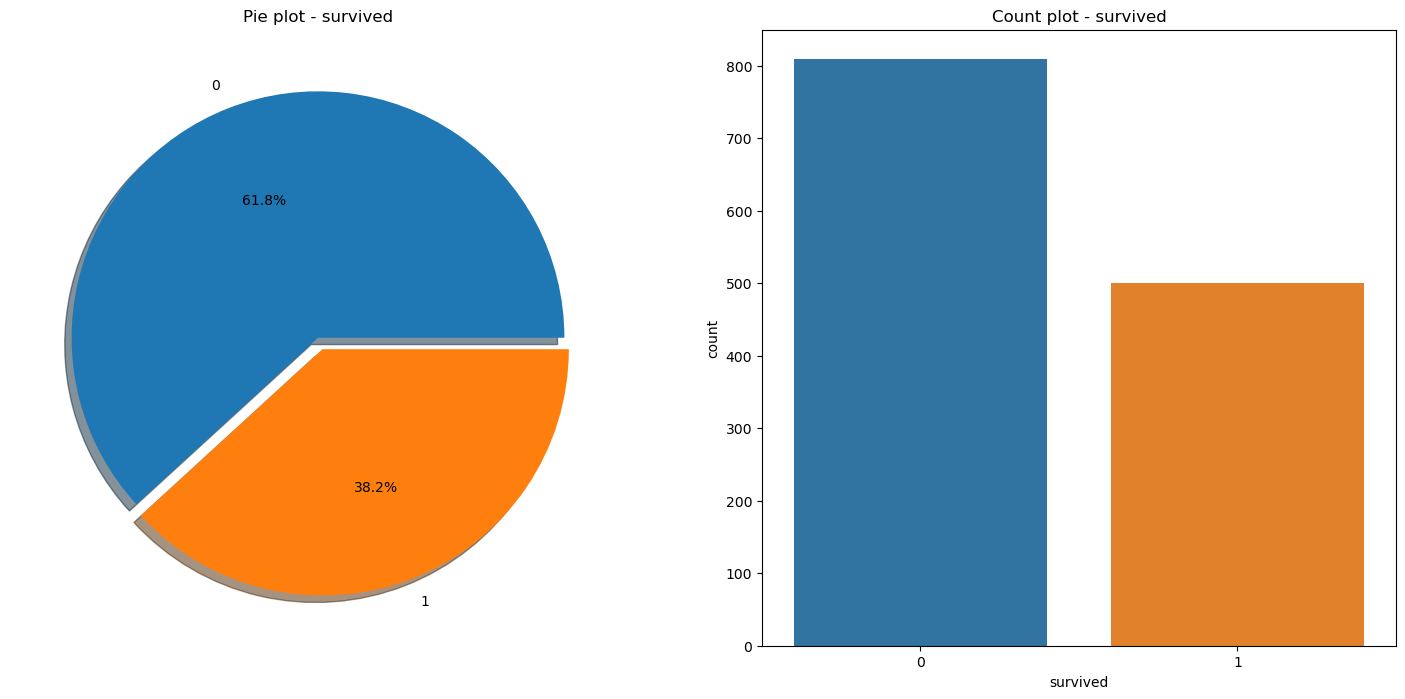
Titanic: Survivor Prediction
- 한명의 페르소나를 가정하고 정말 살 수 없었는지 알아보자!
EDA
- 생존 상황
- pie 그래프와 countplot
fig, ax = plt.subplots(1,2, figsize=(18,8))
titanic['survived'].value_counts().plot(kind='pie',ax=ax[0],shadow=True, explode=[0,0.05] ,autopct='%.1f%%')
ax[0].set_title('Pie plot - survived')
ax[0].set_ylabel('')
sns.countplot(x='survived', data=titanic, ax=ax[1])
ax[1].set_title('Count plot - survived');
- ax로 위치 지정!
- 성별에 따른 생존 상황
fig, ax = plt.subplots(1,2, figsize=(18,8))
sns.countplot(x='sex', data=titanic, ax=ax[0])
ax[0].set_title('Count of passengers of sex')
ax[0].set_ylabel('')
sns.countplot(x='sex', data=titanic, hue='survived' ,ax=ax[1])
ax[1].set_title('Sex : Survived')
plt.show()
- ax[0] 에는 탑승객을 남여로 나눔
- ax[1] 에는 hue에 생존여부를 주어 구분
- 여성 생존 가능성이 높음
- 좌석(경제력)에 따른 생존률
- 좌석과, 생존여부를 확인하기 위해 crosstab 사용
- 두 범주형 컬럼이니깐 가능!
pd.crosstab(titanic['pclass'], titanic['survived'], margins= True)- 1등석의 생존률이 가장 높음
- 선실 등급별 성별
- 여성 생존률이 높고, 1등석 생존률이 높으니깐 1등석에 여성이 많았나 확인 해보아야 한다
grid = sns.FacetGrid(titanic, row='pclass', col='sex', height = 4 , aspect = 2)
grid.map(plt.hist, 'age', alpha=0.8, bins=20)
grid.add_legend();
-
FacetGrid 은 무엇인가 ? (참고 : https://velog.io/@qw2397/ML)
-
1등실에 여성이 많이 보이지는 않는다
- 나이별 승객 현황
import plotly.express as px
fig = px.histogram(titanic, x='age')
fig.show()
- plotly를 사용하면 마우스 오버시 정확한 값을 알 수 있다
- 10대 20대 많다
- 등실별 생존률 연령
grid = sns.FacetGrid(titanic, row='pclass', col='survived', height = 4 , aspect = 2)
grid.map(plt.hist, 'age', alpha=0.8, bins=20)
grid.add_legend();
- 선실등급이 높으면 생존률이 높아 보임
- 나이 5단계 정리
titanic['age_cat'] = pd.cut(titanic['age'], bins = [0,7,15,30,60,100],
include_lowest=True,
labels = ['baby', 'teen','young' , 'adult', 'old'])
titanic.head()- 나이, 성별, 등급별 생존자 수 파악
plt.figure(figsize=(12,4))
plt.subplot(131)
sns.barplot(x='pclass', y='survived', data = titanic)
plt.subplot(132)
sns.barplot(x='age_cat', y='survived', data = titanic)
plt.subplot(133)
sns.barplot(x='sex', y='survived', data = titanic)
- 생존이 1이니깐 값이 높으면 많이 생존 했다는 의미
- barplot에서 보이는 값은 평균이다
- 남/여 나이별 생존 상황
fig, axes = plt.subplots(nrows=1, ncols=2, figsize = (14,6))
women = titanic[titanic['sex'] == 'female']
men = titanic[titanic['sex'] == 'male']
ax = sns.distplot(women[women['survived']==1]['age'], bins = 20,
label = 'survived' ,ax=axes[0], kde=False)
ax = sns.distplot(women[women['survived']==0]['age'], bins = 40,
label = 'not_survived' ,ax=axes[0], kde=False)
ax.legend(); ax.set_title('female')
women = titanic[titanic['sex'] == 'female']
men = titanic[titanic['sex'] == 'male']
ax = sns.distplot(men[men['survived']==1]['age'], bins = 20,
label = 'survived' ,ax=axes[1], kde=False)
ax = sns.distplot(men[men['survived']==0]['age'], bins = 40,
label = 'not_survived' ,ax=axes[1], kde=False)
ax.legend(); ax.set_title('Male')
plt.show()
- bin : 그래프를 쪼개 주는 것
- 몇개로 분포를 보일 것인가
- 신분 정보 파악
import re
title = []
for idx, dataset in titanic.iterrows():
tmp = dataset['name']
title.append(re.search('\,\s\w+(\s\w+)?\.', tmp).group()[2:-1])
titanic['title'] = title
titanic.head()
titanic['title'] = titanic['title'].replace('Mlle','Miss')
titanic['title'] = titanic['title'].replace('Ms','Miss')
titanic['title'] = titanic['title'].replace('Mme','Mrs')
Rare_f = ['Dona', 'Dr', 'Lady', 'the Countess']
Rare_m = ['Capt', 'Col', 'Don', 'Major', 'Rev', 'Sir', 'Jonkheer', 'Master' ]
for each in Rare_f:
titanic['title'] = titanic['title'].replace(each, 'Rare_f')
for each in Rare_m:
titanic['title'] = titanic['title'].replace(each, 'Rare_m')- 정규표현식으로 나타냈음
- 이것은 공부가 필요..
- 신분에 따른 생존률
titanic[['title', 'survived']].groupby(['title'], as_index=False).mean()
머신러닝 생존자 예측
- object 컬럼 변경
- sklearn : LabelEncoder
from sklearn.preprocessing import LabelEncoder
le = LabelEncoder()
le.fit(titanic['sex'])
titanic['gender'] = le.transform(titanic['sex'])
titanic.head()- 결측치 드랍
titanic = titanic[titanic['age'].notnull()]
titanic = titanic[titanic['fare'].notnull()]- 상관관계 확인
correlation_matirx = titanic.corr().round(1)
sns.heatmap(correlation_matirx, annot=True, cmap ='bwr')
- 특성 선택 및 데이터 나누기
- sklearn : train_test_split
from sklearn.model_selection import train_test_split
X = titanic[['pclass', 'age', 'sibsp' , 'parch', 'fare', 'gender']]
y = titanic['survived']
X_train, X_test, y_train, y_test = train_test_split(X,y ,
test_size=0.2,
random_state=13)- Dection Tree 및 평가
from sklearn.tree import DecisionTreeClassifier
from sklearn.metrics import accuracy_score
clf = DecisionTreeClassifier(max_depth=4, random_state=13)
clf.fit(X_train, y_train)
pred = clf.predict(X_test)
print(accuracy_score(y_test, pred))생존률 예측
- 페르소나 만들기
- 우리가 사용한 피쳐
- pclass : 3
- age : 18
- sibsp : 0
- parch : 0
- fare : 5
- gender : 1
persona = np.array([[3,18,0,0,5,1]])
clf.predict_proba(persona)[0,1]- predict_proba 를 사용하면 확률을 보여준다
- 리스트안에 리스트 형태로 첫 번째 값은 0의 확률 두 번째 값은 1의 확률
